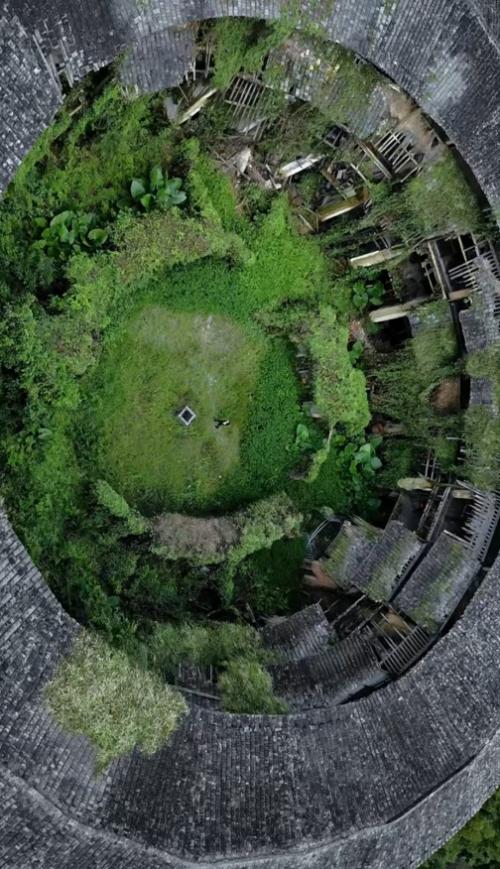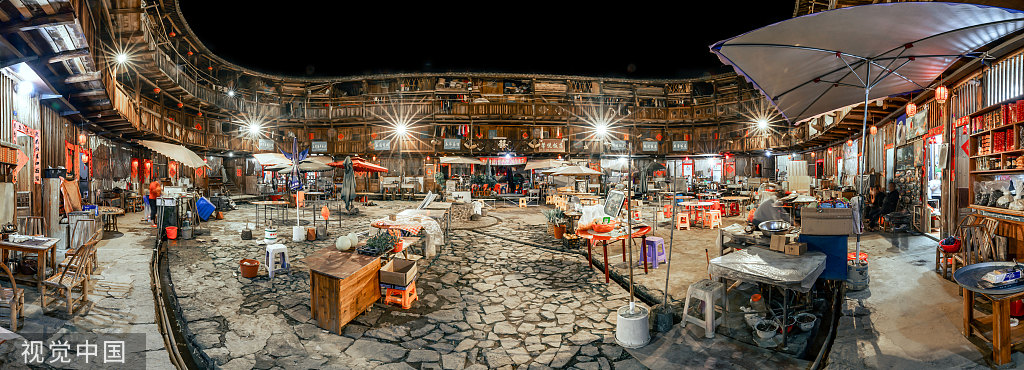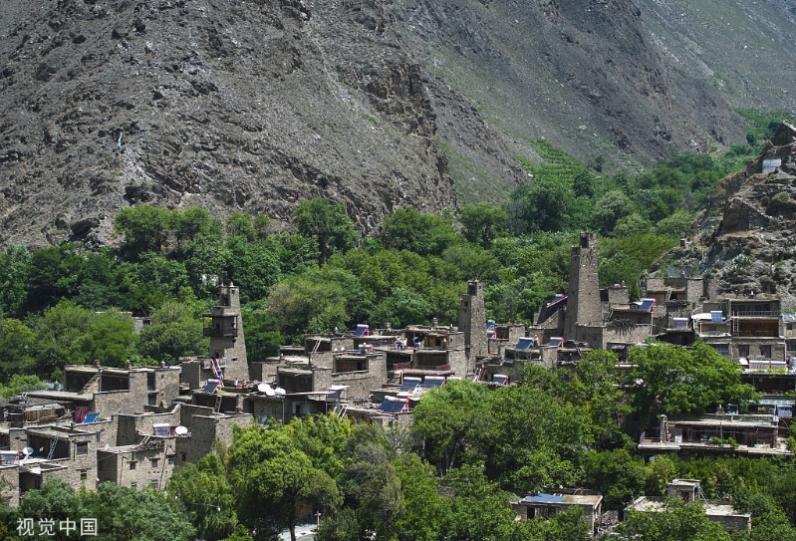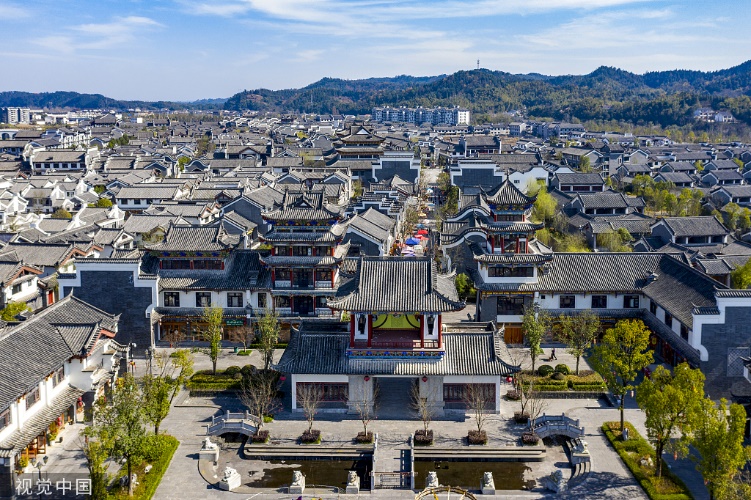1. Introduction
If you walked into a village, would you choose to admire the exquisite architectural forms, or explore the traces of time passing? As a matter of fact, both choices reflect your different ways of understanding and experiencing the landscape. Exquisite architectural forms show people's design wisdom and aesthetic pursuit in a specific historical period, and the shape and decoration of each house contain the artistic style and technical level of the society at that time. On the other hand, the battered walls and potholed streets reveal the ancient charm and infinite charm of this village as well.
In reality, this issue not only troubles us, but also poses significant challenges for those involved in the preservation of cultural landscapes. Time, the most ruthless killer, incessantly ravages the fragile cultural landscape. In the pursuit of reinstating the former grandeur and cultural essence of these landscapes for contemporary audiences, custodians often face a dilemma between choosing conservation methods and contending with the toll of time. Nonetheless, it appears that an ideal solution is far from as straightforward as one might anticipate.
In recent years, the term "landscape" has been widely accepted in the context of natural resources, but how to define landscape from the perspective of history and culture remains a complicated problem. Initially, landscape protection is only the protection of large-scale space, and people are mainly concerned about the appearance expression, composition elements and structural characteristics of buildings. Recently, however, some project conservation planners and landscape architects have proposed a new scope definition of cultural landscape: historical cultural rural landscape is a part of the countryside that embodies its regional historical cultural patterns and values. Among them, villages, market towns, county towns, farms and rural areas are all equal components of it. It's more about what people do and where they live, where they work, how they travel and how they live. The ethnic cultural characteristics of rural areas are the manifestation of social, cultural, economic, and historical attributes, intricately interwoven to form a historical and cultural landscape. These characteristics reflect humanity’s interaction with and utilization of a given region.[1] Whereas, there is still a lack of clear connection between these more abstract academic definitions and the practical application of historic preservation, so the relevant debate about how to preserve and pass on the landscape begins.
Existing literature in this field predominantly focuses on the separate analyses of preserving historical authenticity versus modernizing landscapes. For instance, some studies advocate for the preservation of historical landscape features,[2-4] while others introduce modern design elements to meet contemporary needs.[5- 7] Additionally, there are discussions addressing the tension between preserving historical authenticity and accommodating modern demands.[8] Therefore, there is a pressing need to synthesize scholarly perspectives on the balance between preservation and modernization and to outline strategies for navigating this dichotomy. This paper aims to explore the complexity of landscape heritage through a synthesis of various viewpoints and methods, drawing on practical examples from China, and calls for a deeper understanding of the intricate nature of cultural landscapes to ensure that their multifaceted values and cultural significance are fully respected and preserved.
2. Debate
Taking the Parthenon Temple as an example, Lena Lamerinou believed that an incomplete building would lose its original function and become a work of art, nevertheless, it retains the authenticity of the material, keeps the passage of time and serve as a reliable historical source. If partial restoration is carried out, it is not only necessary to rely on the preservation of accidental original materials, but also will present a subjective "artificial accidental image". The result will lack sufficient authenticity, having an irreversible impact on archaeological history, though a higher degree of completeness is conducive to the audience's understanding.[9]
Yet, is the reality truly as straightforward and ideal as this? Consider two examples as followed.
Commencing with the ‘Dao Feng Lou,’ illustrated in Figure 1, a Tulou located in Houcun, Qiling Township, Zhangzhou, Fujian. Nowadays, it stands desolate and silent, its once vibrant presence as a colossal city-state now reduced to a crumbling old town, abandoned and in decay. Walking inside, what you can see are only broken walls, overgrown branches and vines wandering through the cracks like a bright green waterfall cascading from the sky. Without breath of life, the sun breaks into the gap like a thief, while there were still black abysses that could not be reached, showing a strange desolation.

Figure 1: " The original ecological Dao Feng Lou." Little Red Book, 25 Jul. 2024[10]
As a structure that has undergone virtually no restoration, it presents a research subject of considerable authenticity and exploration value for archaeologists. For travelers seeking an immersive experience of unique regional historical and cultural heritage and residences, it constitutes an exceptionally compelling sightseeing attraction. Moreover, it is not just a precious historical site like the Parthenon Temple. In that village, this kind of buildings serve as the places where the people of Fujian have lived for generations, as vividly shown by the contemporary scenes depicted in Figure 2. With the passage of time, the buildings will gradually old and broken, until the original architectural function is lost. Should people give in to the traces of time, and finally homeless? It follows that the original landscape emerges as a temporal and spatial conduit, allowing visitors to experience the passage of time. In the meanwhile, its scope and scale must be carefully regulated. When the extent becomes considerable, it is no longer merely the historical value that requires attention, the social functions it serves must also be considered. For local inhabitants, the most effective form of preservation may well lie in the pragmatic and meaningful utilization of the invaluable material cultural heritage created by their ancestors.

Figure 2: " The scene of the Fujian people residing within the Tulou. " Visual China Group, 27 Jul. 2024[11]
Additionally, comes the Qiang ethnic village in Sichuan, as depicted in Figure 3. Renowned as one of the more thoroughly preserved and still-inhabited dwellings globally, it features an intricate network of underground waterways, an extensive system of pathways, and a maze-like architectural style that integrates defensive towers with residential spaces. Whereas, the great Wenchuan earthquake wrought severe devastation upon the region. In adherence to heritage conservation principles, the local government undertook a three-year post-disaster reconstruction effort, striving to preserve and utilize traditional craftsmanship and materials to restore the appearance of Taoping Qiang Village to its pre-quake state.

Figure 3: " The distinctive architectural ensemble of Taoping Qiang Village " Visual China Group, 28 Jul. 2024[12]
Although the results of this partial restoration still bear some marks of contemporary construction techniques and raise concerns about the high degree of site integrity, the timely salvage of the Qiang people’s living habitat seems to have made a significant contribution. Might we not reasonably question whether the modern constructions resulting from partial restorations effectively create a dialogue and continuity with the historical site? Such interventions could offer enhanced protection against natural disasters and significantly reduce the likelihood of further human interference from the outset. Could this not represent a more effective preservation strategy in its own right?
In addition, rather than preserving a building's overall design, many conservationists argue that adaptive reuse of buildings - conversion to new, modern, and cost-effective functions - is often the only way to save a building. Sometimes, disadvantageously, this will result in the destruction of the original spatial arrangement, lighting and internal proportions of the building, losing its value as an architectural and historical artifact, or even failing to adapt properly to its new use.[13]
As an illustration, the Taohuayuan Ancient Town in Changde, Hunan, represents a modernized new-style ancient town built with a substantial investment of 5 billion yuan. It aims to integrate special catering、high-end hotels, boutique inns, Ming and Qing style commercial streets, traditional courtyards, and scenic apartments. In spite of that, Liu Xiangnan, a journalist from China Newsweek, reported from Hunan that the ancient town of Taohuayuan has essentially become an ‘empty town’ , as evidenced in Figure 4.

Figure 4: "A depressed scene in Taohuanyuan Ancient Town" Visual China Group, 26 Jul. 2024[14]
Despite adaptive reuse of the buildings, the folkloric village model has resulted in excessive commercialization, severe homogenization of the ancient town, inadequate scenic facilities, and a lack of integration with local culture and customs. It fails to reflect strong regional characteristics or a deep historical culture and has not adapted well to its new purposes. Accordingly, even with grander scales, such efforts fail to attract tourists or retain residents. In summary, modernizing buildings and landscapes may not be an infallible solution. During the transition towards economic efficiency, we inevitably cater to contemporary aesthetics and trends. As a result, regional cultural characteristics gradually diminish in the face of transformation, and landscape construction becomes interspersed with the peculiarities of modern mechanization. Regardless of location, we find ourselves in a series of similar “Insta worsi” spots, prompting us to question the very meaning of travel.
In addition to direct measures applied to existing landscape entities, there is an alternative approach that involves the construction of modern buildings to commemorate cultural heritage and bygone eras. A prime example of this is the work of the renowned architect Wang Peng, who designed the Ningbo Museum using existing remnants of bricks and tiles in the central business district. This edifice, crafted from historical fragments, allows local residents to experience a touch of past life within the modern urban fabric. Wang Peng is dedicated to integrating traditional rammed earth construction techniques into contemporary architecture, exploring the use of earthen materials, and employing unique artisanal skills to blend China’s distinctive cultural heritage into modern structures. His approach also seeks to address the design challenges of entire communities within a single building. As we grapple with the inevitable disappearance of past landscape entities, it is crucial to consider how to cultivate and integrate cultural landscapes into contemporary society.
3. Memory and ruins
If historical cultural landscapes represent a nuanced articulation of the modern artistic interpretation of decayed ancient structures, then ruins serve as a more straightforward expression of this concept. The intrinsic value of ruins often lies in their capacity to embody and evoke memories of past eras. For instance, in Ruskin’s writings, Venice is portrayed as a historical city not only due to its rich ethnic culture and unique geographical conditions but also because of its partially decayed state. Thus, might we discern the intrinsic value and significance of landscapes through our understanding of ruins? Could this insight enable us to pursue more effective preservation strategies?
During the Enlightenment, Piranesi has made historical records of the architectural ruins of the Roman Empire in the special form of engravings and etchings, such as The Main Parts of Architecture (1743), The Diversity of Rome (1743) and the Splendor of Roman Architecture (1761). The ruins displayed in the painting seem to be an impossible architectural masterpiece. In fact, that’s what he exaggerated but accurately superimposed the absolute unique architectural style and various broken images displayed in the course of time with nature. The enchantment of printmaking resides in its ability to blur the boundaries of time and space. Lacking a central perspective and definitive viewpoint, the diffusion of perspectives and the expansion of space can be interpreted in various ways, with history being spatialized and space being temporalized. By fabricating a labyrinth of ruins, he aimed to inspire a genuine imagination grounded in precise historical significance. In his hands, the ruins were imbued with an illusion of vitality, serving as a bridge between antiquity and modernity: intertwining past and present, nature and culture, death and life in a web of mutual oppression. This not only underscores the ephemerality of the present but also serves as a caution against the destructive amnesia of past cultures. His works reflect an alternative understanding of ruins and a critique of both modern aesthetic sensibilities and simplistic interpretations.[15]
Similarly, Andrew Herscher observes that architectural ruins, as spatial traces of political conflict, blur the boundaries between the past and the present. Destruction imposes memory upon architecture, making it unforgettable in a wholly new architectural manner. Only by attempting to construct anti-monumental architecture can we respond informally to political conquest and conceptual interpretation, and thus achieve a continuation of war. Maintaining a critical attitude towards past history and uncertainty towards memory ensures that unexplained memories are not exploited for political purposes.[16]
Perhaps both architectural ruins and cultural heritage are more complex than we imagine. In the same way, the temporal and spatial nature of landscapes is never singular or static. We cannot stand at a single point in the river of history and attempt to interpret or preserve its past. If you wish to take protective and reconstructive measures, can you be certain that your understanding of history is complete? Is your comprehension of the political background necessarily correct? Since there is no guarantee, then respect the vast and great history, do not try to simplify it. Let’s venerate ancient cultural landscapes, maintaining a reverence for their mysteries and allowing our imaginations to roam freely within their boundless depths.
4. Conclusion
Indeed, whether we consider the comprehensive preservation of the Parthenon and the “Tao Feng Tower,” the partial restoration of the Taoping Qiang Village, or the modernization of Taohuayuan Ancient Town, each approach to the preservation and restoration of cultural landscapes has its own merits and drawbacks. What we perceive is merely one facet of the landscape as it manifests in a specific time and space. Regardless of the measures taken, we can only subjectively interpret and infuse it with materials and sensations from different temporal and spatial contexts. By altering its origins, we inevitably influence its future trajectory. It seems that the preservation of landscapes is inherently imperfect. Perhaps, if we relinquish our fixations, we might come to revere its entirety, embrace its imperfections, and appreciate every aspect of it. In doing so, the preservation of landscapes may become not only vibrant and unique but also enduring. What do you think?
References
[1]. H. Tishler, William. “The Landscape: An Emerging Historic Preservation Resource.” Bulletin of the Association for Preservation Technology , 1979, Vol. 11, No. 4 (1979), pp. 9-25.
[2]. Williams, Sarah C. Historic Preservation and the Integrity of Place. Routledge, 2011.
[3]. Johnson, Elizabeth A. Preserving the Past: Historical Preservation and the Challenges of Modernization. Cambridge Scholars Publishing, 2010.
[4]. Stipe, Robert E. The Ethics of Historic Preservation. University of North Carolina Press, 2003.
[5]. Martinez, Jennifer L. Modernization and Heritage: Balancing Contemporary Needs with Historical Value. Oxford University Press, 2018.
[6]. Davis, Michael S. Reimagining Historic Spaces: The Role of Modernization in Preservation. University of California Press, 2012.
[7]. Hines, Laura A. Adaptive Reuse and the Modernization of Historic Structures. Wiley, 2014.
[8]. Rossler, Mechtild. “Applying Authenticity to Cultural Landscapes.” APT Bulletin: The Journal of Preservation Technology, Vol. 39, No. 2/3 (2008), pp.47-52
[9]. Lambrinou, Lena. “Preserving a Monument: The Example of the Parthenon.” Conservation & Management of Archaeological Sites. Mar2010, Vol. 12 Issue 1, p60-74.
[10]. " The original ecological Dao Feng Lou." Little Red Book. ID: 4945902373. http://xhslink.com/A/0VKgEN. Accessed 25 Jul. 2024.
[11]. " The scene of the Fujian people residing within the Tulou. " Visual China Group. ID:VCG211492063871. https://www.vcg.com/creative/1492063871.html. Accessed 27 Jul. 2024.
[12]. " The distinctive architectural ensemble of Taoping Qiang Village " Visual China Group. ID: VCG211507511333. https://www.vcg.com/creative/1507511333.html. Accessed 28 Jul. 2024.
[13]. Archer, Madeline. “Where we stand: Preservation Issues in the 1990s.” The Public Historian, Vol. 13, No. 4 (Autumn, 1991), pp.25-40.
[14]. "A depressed scene in Taohuanyuan Ancient Town" Visual China Group. ID:VCG211327280126. https://www.vcg.com/creative/1327280126.html. Accessed 26 Jul. 2024.
[15]. Huyssen, Andreas. “Nostalgia for Ruins.” Grey Room, Spring, 2006, No. 23 (Spring, 2006), pp. 6-21.
[16]. Herscher, Andrew. “In Ruins: Architecture, Memory, Countermemory.” Journal of the Society of Architectural Historians, Vol. 73, No. 4 (December 2014), pp. 464-469
Cite this article
Zha,F. (2024). Is There an Optimal Way to Pass on Historical and Cultural Landscapes?. Communications in Humanities Research,48,130-136.
Data availability
The datasets used and/or analyzed during the current study will be available from the authors upon reasonable request.
Disclaimer/Publisher's Note
The statements, opinions and data contained in all publications are solely those of the individual author(s) and contributor(s) and not of EWA Publishing and/or the editor(s). EWA Publishing and/or the editor(s) disclaim responsibility for any injury to people or property resulting from any ideas, methods, instructions or products referred to in the content.
About volume
Volume title: Proceedings of the 3rd International Conference on Art, Design and Social Sciences
© 2024 by the author(s). Licensee EWA Publishing, Oxford, UK. This article is an open access article distributed under the terms and
conditions of the Creative Commons Attribution (CC BY) license. Authors who
publish this series agree to the following terms:
1. Authors retain copyright and grant the series right of first publication with the work simultaneously licensed under a Creative Commons
Attribution License that allows others to share the work with an acknowledgment of the work's authorship and initial publication in this
series.
2. Authors are able to enter into separate, additional contractual arrangements for the non-exclusive distribution of the series's published
version of the work (e.g., post it to an institutional repository or publish it in a book), with an acknowledgment of its initial
publication in this series.
3. Authors are permitted and encouraged to post their work online (e.g., in institutional repositories or on their website) prior to and
during the submission process, as it can lead to productive exchanges, as well as earlier and greater citation of published work (See
Open access policy for details).
References
[1]. H. Tishler, William. “The Landscape: An Emerging Historic Preservation Resource.” Bulletin of the Association for Preservation Technology , 1979, Vol. 11, No. 4 (1979), pp. 9-25.
[2]. Williams, Sarah C. Historic Preservation and the Integrity of Place. Routledge, 2011.
[3]. Johnson, Elizabeth A. Preserving the Past: Historical Preservation and the Challenges of Modernization. Cambridge Scholars Publishing, 2010.
[4]. Stipe, Robert E. The Ethics of Historic Preservation. University of North Carolina Press, 2003.
[5]. Martinez, Jennifer L. Modernization and Heritage: Balancing Contemporary Needs with Historical Value. Oxford University Press, 2018.
[6]. Davis, Michael S. Reimagining Historic Spaces: The Role of Modernization in Preservation. University of California Press, 2012.
[7]. Hines, Laura A. Adaptive Reuse and the Modernization of Historic Structures. Wiley, 2014.
[8]. Rossler, Mechtild. “Applying Authenticity to Cultural Landscapes.” APT Bulletin: The Journal of Preservation Technology, Vol. 39, No. 2/3 (2008), pp.47-52
[9]. Lambrinou, Lena. “Preserving a Monument: The Example of the Parthenon.” Conservation & Management of Archaeological Sites. Mar2010, Vol. 12 Issue 1, p60-74.
[10]. " The original ecological Dao Feng Lou." Little Red Book. ID: 4945902373. http://xhslink.com/A/0VKgEN. Accessed 25 Jul. 2024.
[11]. " The scene of the Fujian people residing within the Tulou. " Visual China Group. ID:VCG211492063871. https://www.vcg.com/creative/1492063871.html. Accessed 27 Jul. 2024.
[12]. " The distinctive architectural ensemble of Taoping Qiang Village " Visual China Group. ID: VCG211507511333. https://www.vcg.com/creative/1507511333.html. Accessed 28 Jul. 2024.
[13]. Archer, Madeline. “Where we stand: Preservation Issues in the 1990s.” The Public Historian, Vol. 13, No. 4 (Autumn, 1991), pp.25-40.
[14]. "A depressed scene in Taohuanyuan Ancient Town" Visual China Group. ID:VCG211327280126. https://www.vcg.com/creative/1327280126.html. Accessed 26 Jul. 2024.
[15]. Huyssen, Andreas. “Nostalgia for Ruins.” Grey Room, Spring, 2006, No. 23 (Spring, 2006), pp. 6-21.
[16]. Herscher, Andrew. “In Ruins: Architecture, Memory, Countermemory.” Journal of the Society of Architectural Historians, Vol. 73, No. 4 (December 2014), pp. 464-469









